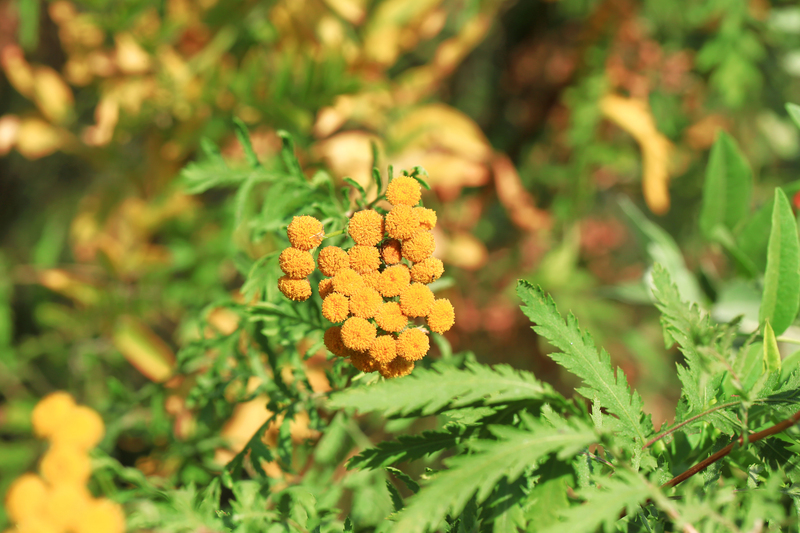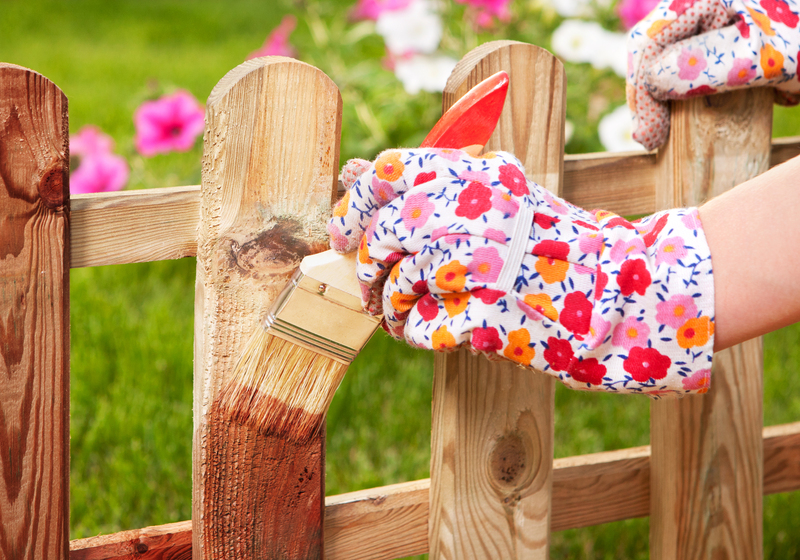Budget-Wise Tips for Low Maintenance Garden Design
Posted on 18/06/2025
Budget-Wise Tips for Low Maintenance Garden Design
Creating a beautiful garden doesn't need to break the bank or demand endless hours of weeding, watering, and pruning. If you dream of an outdoor space that's easy to maintain without compromising on style and function, this guide offers practical, cost-effective strategies. Explore budget-friendly, low maintenance garden design ideas that save money, time, and effort--all while boosting your outdoor enjoyment.

Why Choose a Low Maintenance Garden?
Whether you have a busy lifestyle or simply prefer to spend your time relaxing instead of laboring, low maintenance gardens are ideal. They:
- Reduce ongoing maintenance costs and time
- Minimize water usage and environmental impact
- Stay attractive year-round with minimal effort
Budget-wise garden design isn't about cutting corners--it's about working smart. Let's delve into the best ways to create a stunning, affordable backyard that's easy to care for.
1. Start with a Smart Plan
Design for Simplicity and Efficiency
Planning is the first step in any successful low maintenance landscaping project. Keeping things simple reduces both installation and upkeep costs. Consider these steps:
- Assess your space: Note sun exposure, soil type, and existing plants.
- Define usable areas: Decide on spaces for relaxing, entertaining, or gardening.
- Draw a basic garden layout: Using a simple sketch helps you visualize paths, beds, and features.
Pro Tip: Focus on functionality. Every lawn or flower bed should serve a purpose or be easy to maintain.
2. Choose Easy-Care Plants
Pick Hardy and Native Species
For a true low maintenance garden, select plants that thrive in your local climate and soil. Native species generally require less water, fertilizer, and pest control than exotic or delicate varieties.
- Perennials over annuals: Perennial plants come back year after year, saving you money and time on replanting.
- Drought-tolerant choices: Succulents, ornamental grasses, lavender, rosemary, and sedums are attractive and require minimal watering.
- Evergreen shrubs: These plants offer year-round greenery and structure with little effort.
Grouping plants with similar needs together makes irrigation and care much simpler. Avoid mixing thirsty sun-lovers with drought-resistant shade plants.
3. Mulch Is Your Friend
Mulch helps gardens look tidy and minimizes chores. Here's how mulch supports budget-wise, easy upkeep landscaping:
- Suppresses weeds: A thick layer of mulch stops most weeds from sprouting.
- Conserves soil moisture: Less watering needed--great for your water bill and the environment.
- Improves soil: Organic mulches (like shredded bark or leaf litter) enrich soil as they break down.
Tip: Use inexpensive, local materials like bark chips, straw, or leaves. If you have a wood chipper, make your own mulch from pruned branches!
4. Minimize Lawns and Mow Less
Lawns demand significant water, fertilizer, and weekly mowing. To truly keep your garden low-maintenance and budget-friendly, consider:
- Replacing some or all turf with groundcovers, gravel, or mulch beds.
- Using no-mow grass varieties like fescues for small patches.
- Edging lawns for neatness, so grass doesn't creep into paths or beds.
Reducing lawn area not only saves time and money but can open up space for more visually interesting features.
5. Opt for Hardscaping Solutions
Low Maintenance Surfaces
Hardscaping--such as patios, gravel paths, or stepping stones--adds structure and function to your garden with minimal effort. Advantages of hardscaping in a budget-wise low maintenance garden include:
- No watering or trimming needed
- Reduces overall garden area that needs care
- Materials like gravel and pavers are often affordable and long-lasting
For DIY savings, use recycled materials, such as broken concrete "urbanite," bricks from demolitions, or secondhand pavers. Well-placed rocks or logs can also define borders at minimal cost.
6. Install Automatic Irrigation... or Go Manual Smartly
Watering is one of the biggest time and money sinks for gardeners. Budget-conscious tips:
- Drip irrigation: This system delivers water directly to plant roots, reducing waste and weed growth. Kits are affordable and can be added in stages.
- Soaker hoses: A cost-effective alternative for garden beds.
- Watering cans: For small gardens, hand-watering at the base of plants wastes less water and encourages deeper roots.
Set watering times for early morning or late evening to minimize evaporation and keep plants healthier with less water.
7. Use Raised Beds and Smart Borders
Raised beds are not only attractive--they're part of any easy-care, budget-wise garden:
- Better soil control: You can custom-blend soil, which helps plants thrive with less attention.
- Improved drainage: Less risk of soil compaction or root disease.
- Easy to weed and maintain: Reduces bending and makes chores simpler.
For affordable raised beds, use repurposed lumber, bricks, or stones.
Add clear borders or edging to keep mulch and gravel where it belongs and to prevent grass from invading flower beds.
8. Reuse and Repurpose
Get creative and save money by repurposing items in your garden design:
- Use old containers as quirky planters
- Create decorative trellises from leftover wood or metal
- Install garden benches from reclaimed pallets
Secondhand shops can be gold mines for interesting garden decor and functional features. Repurposing isn't just thrifty--it's eco-friendly and unique!
9. Tackle Weeds the Smart Way
Weeding can quickly become overwhelming. Keep it under control with these cost-effective, easy maintenance strategies:
- Mulch, mulch, and more mulch (seriously--it's that effective)
- Dense groundcovers to crowd out weeds (like creeping thyme or ajuga)
- Landscape fabric under gravel or stone paths
Regular, quick walk-throughs make it easy to pull small weeds before they get out of hand, so you'll rarely face a big weed problem.
10. Keep Tools Simple and Well-Chosen
For truly low maintenance gardening on a budget, don't waste money on fancy gadgets. Instead:
- Invest in a few quality tools: A sharp spade, hand trowel, pruners, and a sturdy rake cover most needs.
- Store tools under cover to prolong their life--save money you'd spend on replacements.
- Clean and oil tools after use so they're always ready for the next job.
Look for deals at local garden centers, garage sales, or online marketplaces for gently used equipment.
Extra Money-Saving Tips for Low Maintenance Gardeners
- Propagate your own plants: Grow more for free from seeds or cuttings of existing favorites.
- Swap with friends and neighbors: Trading plants and seeds is fun and free.
- Use rain barrels: Collect rainwater for irrigation and cut down on water bills.
- Compost: Kitchen and garden waste can be turned into rich, free soil amendment--reducing the need for bought fertilizer.
- Plan for all seasons: Choose a mix of evergreens and year-round interest plants to avoid costly seasonal overhauls.
What Garden Features to Avoid If You Want Low Upkeep and Low Costs
- Large, high-maintenance lawns that need constant mowing and fertilizer.
- Exotic water features or ponds that require pumps and regular maintenance.
- Complex perennial borders with high-maintenance annuals or tender plants.
- Intricate hedge designs requiring precise pruning.
The simpler the layout, the fewer ongoing chores--and the smaller your investment of time and money.
Putting Low Maintenance and Budget-Wise Tips Into Action
Ready to start your affordable, easy-to-care-for garden? Here's a basic step-by-step approach:
- Sketch your basic design, focusing on simplicity and clear zones.
- Select a palette of easy-care, drought-resistant, and native plants.
- Install creative hardscaping solutions--gravel, stepping stones, and reclaimed paths for instant structure.
- Lay mulch immediately after planting to minimize weeds and watering needs.
- Consider drip irrigation or efficient hand watering solutions.
- Add unique touches with upcycled containers, benches, and simple garden art.
- Establish and stick to a short, regular maintenance routine.

Frequently Asked Questions on Budget-Wise Low Maintenance Gardening
Can I have a colorful garden and still keep it low maintenance?
Absolutely! Focus on long-blooming perennials, self-seeding annuals, and variegated foliage plants. Use splashes of color from hardy bushes, bulbs, or ornamental grasses for year-round interest.
How can I design a low maintenance garden in a small urban space?
Prioritize container gardening and vertical solutions like wall planters to maximize space. Artificial turf or gravel can keep things neat without upkeep, while small shrubs and climbers offer plenty of seasonal beauty.
What is the cheapest way to mulch a garden?
Make your own mulch from leaves, grass clippings, or chipped branches. Ask local tree services for free or low-cost wood chips. Some municipalities also offer free compost or mulch for residents.
Are there any flowering plants that require almost no care?
Yes! Try daylilies, sedums, black-eyed susan, coneflower, and lavender. Once established, they thrive on neglect and produce abundant blooms year after year.
Conclusion: Your Path to a Stress-Free, Affordable Garden
Low maintenance doesn't mean lifeless--and budget-wise doesn't mean boring! By using smart design principles, careful plant selection, and a dash of creativity, you can achieve a stunning outdoor space that fits your lifestyle and your wallet. Focus on simplicity, practicality, and reusing what you can.
Start small and build over time. With these practical budget-wise tips, your low-maintenance garden will only get better each year--without the high cost or hard labor.
Ready to put these ideas to use? Share your own favorite low maintenance gardening tips below and join the movement toward beautiful, affordable, easy-care gardens!



